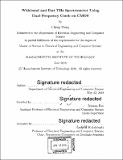Wideband and fast THz spectrometer using dual-frequency-comb on CMOS
Author(s)
Wang, Cheng
DownloadFull printable version (9.407Mb)
Alternative title
Wideband and fast Terahertz spectrometer using dual-frequency-comb on Complementary metal-oxide-semiconductor
Other Contributors
Massachusetts Institute of Technology. Department of Electrical Engineering and Computer Science.
Advisor
Ruonan Han.
Terms of use
Metadata
Show full item recordAbstract
Millimeter-wave/terahertz rotational spectroscopy of polar gaseous molecules provides a powerful tool for complicated gas mixture analysis. Here, a 220-to-320 GHz dual-frequency-comb spectrometer in 65-nm bulk CMOS is presented, along with a systematic analysis on fundamental issues of rotational spectrometer, including the impacts of various noise mechanisms, gas cell, molecular properties, detection sensitivity, etc. The spectrometer utilizes two counter-propagating frequency-comb signals to seamlessly scan the broadband spectrum. The comb signal, with 10 equally-spaced frequency tones, is generated and detected by a chain of inter-locked transceivers on chip. Each transceiver is based on a multi-functional electromagnetic structure, which serves as frequency doubler, sub-harmonic mixer and on-chip radiator simultaneously. In particular, theory and design methodology of a dual transmission line feedback scheme are presented, which maximizes the transistor gain near its cut-off frequency fmax. The dual-frequency-comb scheme does not only improve the scanning speed by 20 x, but also reduces the overall energy consumption to 90 mJ/point with 1 Hz bandwidth (or 0.5 s integration time). With its channelized 100-GHz scanning range and sub-kHz specificity, wide range of molecules can be detected. In the measurements, state-of-the-art total radiated power of 5.2 mW and single sideband noise figure (NF) of 14.6~19.5 dB are achieved, which further boost the scanning speed and sensitivity. Lastly, spectroscopic measurements for carbonyl sulfide (OCS) and acetonitrile (CH3CN) are presented. With a path length of 70 cm and 1 Hz bandwidth, the measured minimum detectable absorption coefficient reaches [alpha] gas,min=7 .2 x 10-7 cm- 1 . For OCS, that enables a minimum detectable concentration of 11 ppm. The predicted sensitivity for some other molecules reaches ppm level (e.g. 3 ppm for hydrogen cyanide (HCN)), or 10 ppt level if gas pre-concentration with a typical gain of 10 5 is used.
Description
Thesis: S.M., Massachusetts Institute of Technology, Department of Electrical Engineering and Computer Science, 2018. Cataloged from PDF version of thesis. Includes bibliographical references (pages 71-75).
Date issued
2018Department
Massachusetts Institute of Technology. Department of Electrical Engineering and Computer SciencePublisher
Massachusetts Institute of Technology
Keywords
Electrical Engineering and Computer Science.